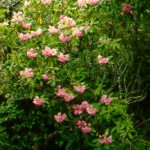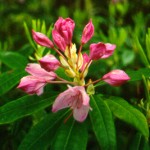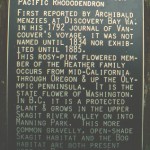Rhododendron LakeRhododendron Lake lies in the Englishman River drainage about 20 kilometres (12 miles) west of Nanaimo at an elevation of 450 metres (1475 feet). On the right is an image from Google Earth showing Rhododendron Lake and the west end of Nanoose Bay at the top [click on the image for an enlarged view]. If you have Google Earth installed on your computer, then click on the Rhododendron Lake Placemark.
Aerial view in late May looking west across Rhododendron Lake in the foreground toward Mt Moriarity on Rhododendron Lake is located in the Northwest Bay Division private forest land owned by Mosaic’s Northwest Bay. [For information about access times and road conditions, telephone the North West Bay regional office at 250 468-6810.] From the parking lot, there are trails into the rhododendrons with interpretative signs. There is another small grove about 70 km south of Rhododendron Lake and 18.5 km west of Shawnigan Lake on the road to Port Renfrew at an elevation of 520 m. It is also on private forest land owned by Island Timberlands LP.
The Pacific Rhododendron is much more common in the state of Washington where it was adopted as the state flower. It is most prevalent in Oregon and occurs in several locations in California (see maps and descriptions in the Western North American Rhododendron Species Project). Only the Skagit River population has protection in British Columbia under the ecological reserves act (see article by Dean Goard of the Victoria Rhododendron Society).
The Englishman River watershed is part of the Mount Arrowsmith Biopshere Reserve that was designated in November 2000 by the Man and Biosphere Program of the United Nations’ Education, Science, and Cultural Organization. The Pacific Rhododendron has a vigorous root system and is more drought tolerant than many of the hybrids available from commercial nurseries. There are selected forms which have been introduced into cultivation that have a range of flower colours from white to darker red than the native form.
Clade 1 is generally found near the ocean. Clades 2 and 4 are the principal forms at mountainous sites in British Columbia and southern Oregon. Clade 3 is the main type found in the Cascade Mountains in Oregon. The Mt Elphinstone and Weeks Lake (Shawnigan) populations contain clade 1, as do the plants around Puget Sound. However, the plants at Rhododendron Lake have clades 2 and 4, indicating that they are closely related to those in Manning Provincial Park. Click here for article on Dr Hall’s faculty webpage. Clive |
-
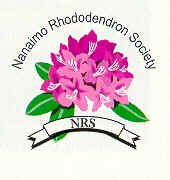 Meetings are held at 7:30pm on the second Thursday of each month from September through May at Beban Park, 2300 Bowen Road, Nanaimo, BC
Meetings are held at 7:30pm on the second Thursday of each month from September through May at Beban Park, 2300 Bowen Road, Nanaimo, BC
Our Latest Newsletter
Download our most recent newsletter (pdf format) - this large file may take a little time to download to your device.

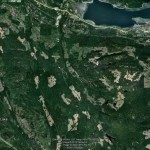
![Winter view Rhododendron Lake below Okay Mountain - [Click photo to enlarge]](http://nanaimorhodos.ca/wp-content/uploads/2012/08/Mount-Benson-750-150x150.jpg)
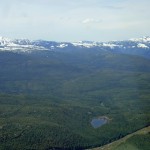
![Macrophyllum Bloom View toward the lake through the grove - [Click photo to enlarge]](http://nanaimorhodos.ca/wp-content/uploads/2012/08/Macrophyllum-Bloom-150x150.jpg)
